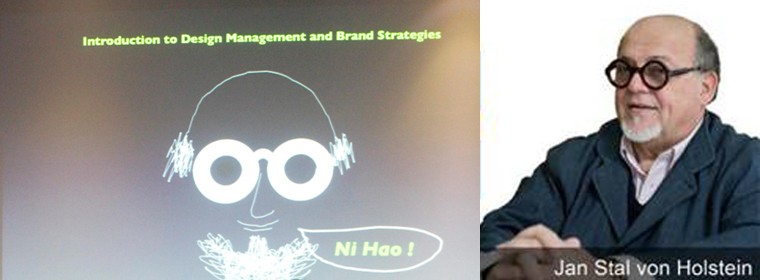A few minutes with Jan Staël von Holstein
news
13.11.21

Now products and inventions are developed based on what consumers really need and what experiences they have. I know China Bridge is very good at it. Firms like CBi can help companies in understanding Chinese consumers and markets.
Jan Staël von Holstein, a long time friend and mentor to CBi China Bridge, has spent over four decades contributing greatly to field of Design. His mastery in Corporate Brand Identity Design and Design Management are widely acknowledged in the industry.He founded ‘The Network with a silver lining’, a network of 16 design offices around Europe and the USA serving as a platform for business in and out of China with local operations in Shanghai and Hong Kong. He also teaches at The College of Design & Innovation of Tongjii University, HULT International Business School in Shanghai and Design Management Institute, Tsinghua University. Recently Professor Holstein spent a few minutes with our editorial team to discuss the differences between design environments of the East and West, and the future of design in China. His views present critical insights into the industry as well as some valuable pieces of advice for young designers.
Q: How has been the experience of teaching in China? In what ways did the cultural differences influence your teaching style?
It has been a very rewarding experience. My observation is that Chinese students are more diligent compared to those in the West. However, the teaching style is quite streamlined and students are not generally encouraged to have a very strong dialogue with teachers and ask them or disagree with them. Therefore, it takes a bit of time for them to get liberated and start seeking their own ideas and directions. I don’t want to imply that Chinese students are not creative; it’s just that period in school when sometimes they are not there to dive into new directions that quickly. To overcome this and to encourage dialogue and more class participation I now conduct more workshops.
Q: Could that be the reason that there is greater focus on adaption of products and ideas to local needs rather than on inventing new ones?
I think there is a clear link. China has been more focused on production as opposed to creating new products and breakthroughs. However, I don’t think China is lacking scope for innovation as there are huge investments being carried out in many areas like space or genetics. On the other hand, if we are talking more about consumer oriented things like furniture or products in our daily lives then it has been quite a long period of imitating the west as opposed to creating their own. That of course is changing, there are a lot of things happenings, it’s also aided by the fact that a lot of students go abroad for a few years and continue to study or work and when they come back, they are much more forcefully developed.
Q: Keeping that in mind, how do you see the future of design industry in China? How do you view the possibility of exciting new user oriented products coming out of the local industry and achieving a global scale?
I have no doubt about that. Although there are not a lot of such products in the market yet, but there are probably quite a few in development or in laboratories. The work going on in space operations could be one example. More at hand example would be the car industry. I look at China’s development in two dimensions, one I call ‘wants’ which concern the consumer market relating to what people want. The other one is ‘needs’ and when it comes, for example, to commerce, China’s needs are very different than the West. There is a natural need to develop a car which can run on some new kind of fuel and is eco friendly. I predicted a few years ago, though we haven’t seen it yet, that China will have one of the best designed cars for the future. Not only in terms of styling but also in terms of how it operates. There is breakneck development going on already with electric cars all over China, but I am talking about the next dimension and not only electric cars. There is a great chance that it could come out of China.
Q: What would be the one thing that West could learn from China?
There are a lot of things that we can learn from China. Particularly if you look in to the history, West copied china long time ago. One example is porcelain. China still makes one of the most exquisite Burslem in the world. The method to make burslem was copied by the west several hundred years ago. Moreover, designers in Scandinavia took a lot of inspiration from Chinese furniture design. Cases of textile and silk are also similar. However, Contemporary society is built on a lot of technology; China has been lacking innovation a bit in this field. Combining traditional concepts with new inventions, styles and ideas is in the process of happening in China and I have no doubt that it will happen because there is still a lot of inspiration to be sought in Chinese culture. Same thing will happen in fashion. In fact, recently I went to London fashion week to see presentation of young Chinese designer called Hai Shang Wang, it was a very interesting collection and it had elements of Chinese character as well as Western. Fashion industry in history, very often, has been the place where these things start to happen, and then they penetrate other areas such as graphic design and media.
This symposium served as a communication platform for product designers, UI designers, Visual communication designers, UX professionals and so forth in Shanghai Internet and Mobile Internet industries. The 300 seats conference room was filled with guests and the broad topics discussed were highly popular among them. The organization committee invited 10 guest speakers including Hong Zhu, China UX Preacher at Microsoft, Liqun Zhang, Director of design management Institute of Shanghai Jiao Tong University, David Li, Founder of Xin Chejian and others.
As one of the guest speakers, Daniela Mao, UX Design Director at CBi China Bridge, shared CBi’s experience in participative co-creation in recent years, which was highly welcomed by participants. In the Q & A session, many people expressed their interest in this topic and in CBi and some participants continued the discussion with CBi team after the event.
Such events are very useful and necessary as they facilitate communication in the industry as well as provide a good platform for the public to obtain the frontier information. CBi China Bridge strives to make impact for the industry and we are always glad to share our experience and let more people access to CBi.
Connect with us to learn more
We look forward to hearing from you.

